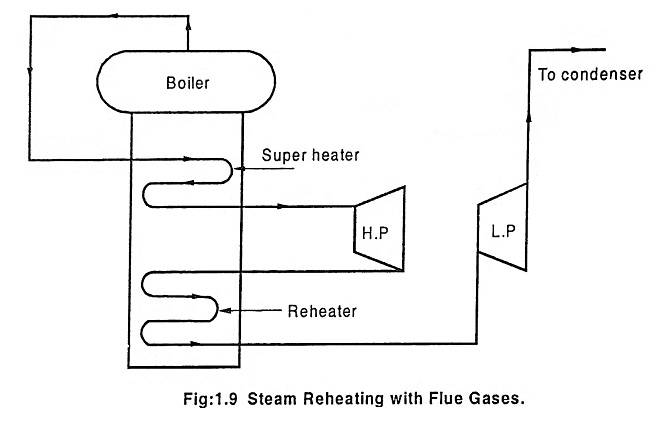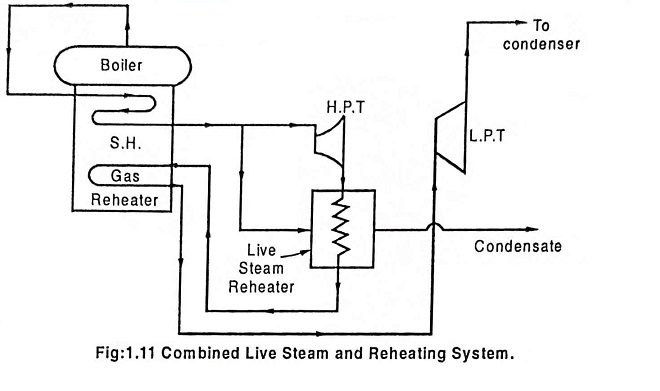Reheat Cycle in Steam Power Plant:
Reheat Cycle: If the dryness fraction of steam leaving the turbine is less than 0.88, then corrosion and erosion of turbine blades occur. To avoid this situation, reheat is used.
In the reheat cycle in steam power plant, the expansion of steam takes place in one (or) more turbines. Steam is expanded in the HP turbine first, then it is reheated. The reheated steam is again expanded in the LP turbine. reheat cycle in steam power plant gives small increase in cycle efficiency. It increases the net work output.
Reheating means heating the steam between turbine stages (between HP stage and LP stage).
- P1 – Boiler pressure;
- P2 = P3 = Reheat pressure;
- P4 = Condenser pressure;
- T1 = boiler temperature (or) superheat temperature;
- T3 = Reheat temperature.
Note:
If T3 is not given, then we can assume T3 = T1
h1, h2, h3, h4 – Take from mollier chart (h – s diagram) (or) from steam table.
h5 = hf for condenser pressure.
[ vf = sp. volume of fluid at condenser pressure]
The ordinary Rankine cycle efficiency can be increased by increasing the pressure and temperature of the steam entering into the turbine. When the initial pressure increases, the expansion ratio in the turbine also increases, and the steam becomes quite wet at the end of expansion. This is not desirable because the increased moisture content of the steam causes corrosion in the turbine blades and so increase the losses. Due to this, the nozzle and blade η is decreased.
In reheat cycle in steam power plant, the steam is taken out from the turbine and it is heated by the flue gases in the boiler.
The main purpose of reheating is to increase the dryness fraction of steam passing through the lower stages of the turbine. The dryness fraction of steam coming out from the turbine should not fall below 0.88. By using the reheat cycle in steam power plant, the specific steam consumption decreases and ηthermal also increases. The increase in ηthermal due to reheat depends upon the ratio of reheat pressure to original pressure of steam. The reheat pressure is generally kept within 20% of the initial pressure of steam:
At low pressure, the η of the cycle is reduced.
It is preferred for only high capacity plants, (or) 50,000 kW and the steam pressure range is 100 kgf/cm2 – ab)
Advantages (or) effects of Re-heating:
- Due to reheating, net work done increases
- Due to reheating, heat supply increases
- Due to reheating, thermal efficiency increases
- Due to reheating, the turbine exit steam dryness fraction increases – so moisture decreases – so blade erosion becomes minimum – so life of the turbine will be increased.
- It reduces the fuel consumption upto 4 to 5%.
- The size of the low pressure turbine blades can be reduced.
- It reduces the steam flow of 15 to 20% with corresponding reductions in boiler, turbine and feed water heating equipment’s.
- It also reduces the pumping power.
- Less costly materials are used for lower steam pressures and temperatures to obtain required thermal efficiency.
- It has higher thermal η.
- It has reduced feed pump power.
- The condenser and boiler sizes are small.
- The turbine has a very long life.
Disadvantages:
- This cycle is more expensive than simple Rankine cycle.
- It occupies more space.
- The second stage turbine blade’s design is complicated and expensive.
- The operation and control reheat rankine cycle is
- At light loads, the superheated steam will overheat the blades. To avoid this, the feed water should be sprayed on the blades.
Methods of Reheating:
- Gas reheating
- Live-steam reheating
- Combined gas live steam reheater
1. Gas Reheating:
The steam taken from the high pressure turbine (HP) turbine is sent back to the reheater to reheat the steam to its initial throttle temperature.
The reheater is normally placed after the superheater so that the superheater receives the flue gases first and then the reheater receives flue gases. Since the reheater should operate at much smaller temperature difference between the gas and steam, the counter flow heat exchanger is used for reheating.
To make the steam to be reheated to its initial throttle temperature in this gas reheating system, the following disadvantages are faced.
- Long and large pipe connections are required and hence cost is more and the pressure drop becomes higher.
- For piping system, the expansion and contraction allowances should be given.
- The amount of steam stored within the piping and reheater may cause considerable rise in turbine speed and it leads to accident in case of failure of emergency control.
2. Live-Steam Reheating:
The live steam reheating circuit is shown in Fig.1.10. The high pressure steam from the superheater is used for reheating the steam coming out from the HP turbine in a specially designed reheater.
The advantages of live-steam reheating over gas heating are given here.
- The operation of this reheating system is simple.
- The reheater can be placed near the HP turbine and minimize extra pipe fittings.
- The control of temperature is easy since varying combustion condition will not affect the live steam reheater performance.
- Wet steam can also be reheated.
- More than one reheating can be used since the piping requirements are less.
3. Combined gas and live steam reheater:
The combined gas and live steam reheater system is shown in Fig.1.11. Live steam reheating system does not allow the steam to be reheated to its initial throttle temperature. By using combined reheating system, this problem can be solved. The live steam reheating system is placed in series with the gas reheater. The steam extracted from HP turbine is first sent to live steam reheater and then to gas reheater as shown in fig. In order to maintain a constant final temperature, the supply of live steam to first reheater is thermostatically controlled.






